Students can Download 1st PUC Biology Model Question Paper 3 with Answers, Karnataka 1st PUC Biology Model Question Papers with Answers helps you to revise the complete Karnataka State Board Syllabus and score more marks in your examinations.
Karnataka 1st PUC Biology Model Question Paper 3 with Answers
Time: 3.15 Hours
Max Marks: 70
General Instructions:
- The question paper consists of four parts A, B, C and D.
- All the parts are compulsory.
- Draw diagrams wherever necessary. Unlabelled diagrams or illustration do not attract any marks.
Part – A
Answer the following questions in one word or one sentence each: ( 10 × 1 = 10 )
Question 1.
Define species
Answer:
Group of individual organisms with fundamental similarities.
Question 2.
Define phyllotaxy.
Answer:
The pattern of arrangement of leaves on the stem or branch.
Question 3.
Define tissue.
Answer:
A group of cells having common origin and performing common function.
Question 4.
What are polysomes?
Answer:
Series of ribosomes attached to single mRNA to form a chain.
![]()
Question 5.
Why mitosis is called equational division?
Answer:
Since chromosome number remains constant from parent cell to daughter cell
Question 6.
What is cell cycle?
Answer:
A sequence of events by which a cell duplicates its genome, synthesis of other constituents and eventually divides into two daughter cells.
Question 7 .
Define osmosis.
Answer:
The diffusion of water across a differentially or semipermeable membrane.
Question 8.
Name the nodule forming bacteria in leguminous plant
Answer:
Rhizobium.
Question 9.
Name structural functional unit of kidney
Answer:
Nephron.
![]()
Question 10.
Name the locomotary structures of Hydra.
Answer:
Tentacles
Part – B
Answer any five of the following questions in 3-5 sentence each. Wherever applicable: ( 5 × 2 = 10 )
Question 11.
Name the algal and fungal components of Lichens.
Answer:
- Phycobiont – Algal component
- Mycobiont – Fungal component.
Question 12.
Write the modification of birds for flight.
Answer:
- Fore limbs are modified into wings
- Bones pneumatic
Question 13.
Draw a neat labelled diagram of areolar tissue.
Answer:

Question 14.
Mention types of chromosomes based on position of the centromere.
Answer:
- Metacentric
- submetacentric
- acrocentric
- telocentric.
![]()
Question 15.
Mention the significance of meiosis
Answer:
- Conservation of specific chromosome number of a species in sexually.
- reproducing organism.
- Brings about variability in sexually reproducing organisms.
Question 16.
Name the technique of growing plant in soil free nutrient solution. Who discovered it?
Answer:
- Hydrophonics
- Julius Von Sachs
Question 17.
Distinguish differentiation from de-differentiation.
Answer:
- Cell derived from root and shoot apical meristem and mature to perform specific function.
- The living differentiated cells regain the capacity of division.
![]()
Question 18.
Discus the role of ADH in urine formation.
Answer:
- Facilitates water absorption from later parts of tubule.
- prevents diuresis.
- constricts blood vessel and increase blood pressure.
- increase GFR.
Part – C
Answer any five of the following questions in about 40-80 words each wherever applicable: ( 5 × 3 = 5 )
Question 19.
Write the universal rule of nomenclature
Answer:
- Biological names are generally in latin and written in English.
- The first word represents genus second word represents species.
- When written should be underlined separately.
- When printed in English it should be italics.
- The first letter of the genus should commence from capital letter first letter of species should commence from small letter.
Question 20.
Mention types of flower based on position of the ovary.
Answer:
- Hypogynous
- Perigynous
- Epigynous
Question 21.
Draw neat labelled diagram of stomal apparatus
Answer:
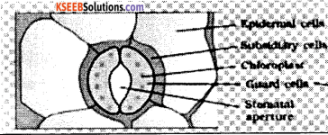
Question 22.
What are micro nutrients? Mention any four.
Answer:
- The nutrients present in excess of 10m mole Kg-1 are called macro nutrients.
- Carbon, hydrogen, oxygen, nitrogen, phosphorus, sulphur, potassium, calcium and magnesium.
![]()
Question 23.
Discuss any three role of auxins.
Answer:
- Apical dominance.
- Parthenocarpy.
- Herbicide controls.
- Xylem differentiation.
- Helps in cell division
Question 24.
Explain the carbohydrate digestion in intestine.
Answer:
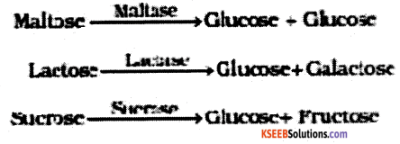
Question 25.
Explain the transport of Carbon dioxide by blood.
Answer:
- 20-25 % of Carbon dioxide is carried by hemoglobin as carbamino-hemoglobin.
- When pCO2 is high and pO2 is low as in the tissue more binding of CO2 occurs, where as when pCO2 is low and pO2 high as in the alveoli, disassociation of CO2 from carbmino- hemoglobin takes place.
- CO2 + H2O – H2CO3 – HCO3+ H+
![]()
Question 26.
Write the difference between cardiac muscle and skeletal muscle.
Answer:
Cardiac Muscle
Skeletal Muscle
- Short in size
Long in size - Binucleate
Multinucleate - Cross Bridges present
Cross bridges absent - Myofibrils faint
Myofibrils prominent
prominent - Branched
Unbranched - Found in heart
attached to skeletal tissue
Part – D
Section – I
Answer any four of the following question in about 200-250 words each, wherever applicable: ( 4 x 5 = 20 )
Question 27.
List the salient features of Bryophyta.
Answer:
- Habitat-cold moist shady places.
- Amphibious nature, depends on water for sexual reproduction.
- Plant body thallus – with rhizoids.
- Plant bodies haploid dominant photosynthetic gametophyte.
- Gametophyte bears antheridia – male and archegonia -female reproductive structures.
- Sporophyte diploid produces spores in capsule.
- Gametophyte alternates with sporophyte Any five lmark each
Question 28.
Write the general characters of phylum Annelida.
Answer:
- Organ system grade.
- Bilaterally symmetrical triploblastic.
- Segmented.
- Coelomate.
- Locomotion by parapodia
- Excretion by nephridia.
- Nervous system by paired ganglia lateral nerves with double ventral solid nerve chord.
- Dioceous or monocious
![]()
Question 29.
Explain the morphological features of Cockroach
Answer:
- Body divisible into head thorax and abdomen
- Head made of six fused segments
- Head consist of antenna compound eyes, and mouth parts.
- Short neck connect head and thorax.
- Thorax made of three segment prothorax, mesothorax and metathorax.
- Meso and metathorax bears two pairs of wings.
- Thoracic segment bears three pairs of legs.
- Abdomen made of ten segments.
- Tensegment consist of anal cerci males consists of anal styles on 9th segment. Any other morphological to be considered
Question 30.
Draw a neat labeled diagram of plant cell.
Answer:
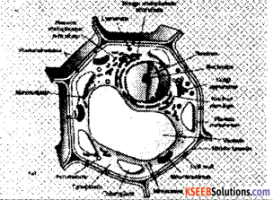 <
<
Question 31.
Explain the classification enzymes.
Answer:
- Oxidoreductases- dehydrogenases-catalyzes oxido reduction between substrates.
- Transferases- catalyze group transfer between substrates.
- Hydrolases- Catalyze hydrolysis of ester, ether, peptide, glycosidic bond.
- Lyases- catalyze removal of groups from substrate by mechanisms other than hydrolysis, leaving double bond.
- Isomerases- catalyze inter conversion of the optical or geometric or positional isomers.
![]()
Question 32.
Explain Double circulation.
Answer:
- Deoxygenated blood collects in right atrium by two vena cava.
- Oxygenated blood collects in left atrium by pulmonary veins.
- Deoxygenated bold from right atrium and oxygenated blood from the left atrium moves to right and left ventricles respectively.
- Deoxygenated bold from right ventricle and oxygenated blood from the left ventricle moves to pulmonary artery and systemic aorta.
- Deoxygenated bold through pulmonary aorta moves to the lungs for oxygenation.
- Oxygenated blood through systemic aorta is supplied to the different parts of the body.
- Diagram.
Section – II
Answer any three of the following questions in about 200-250 words each, wherever applicable: ( 3 x 5 = 15 )
Question 33.
Explain the mechanism of ascent of sap
Answer:
- A transpiration driven ascent of xylem sap depends mainly on the following physical properties of water
- Cohesion – mutual attraction between water molecule
- Adhesion attraction of water molecules polar surfaces such as tracheary elements.
- Surface tension -water molecules are attracted to each other in a liquid phase than in gas phase.
- These properties gives water ability to rise in the thin tubes.
- Water evaporates through stomata it results in pulling of water into leaf from the xylem transpiration can generate pull sufficient to lift a xylem sized column of water over 130 meters.
Question 34.
Write schematic representation of Calvin cycle
Answer:
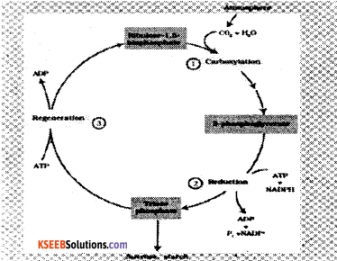
Question 35.
a. Briefly explain alcoholic fermentation
Answer:
- It occur in yeast.
- It involves anaerobic break down of glucose in absence of oxygen.
- Enzyme pyruvic acid decarboxylase and alcohol dehydroginase catalyse reactions.
- Carbon dioxide and ethanol are the end products.
b. What is RQ? Name the respiratory substrate whose RQ value is 1.
Answer:
- The volume of carbon dioxide released to the volume of oxygen consumed during aerobic respiration/respiration is called RQ.
- Glucose or carbohydrate.
![]()
Question 36.
Draw a neat labelled diagram of Neuron.
Answer:
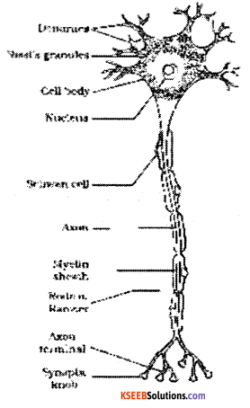
![]()
Question 37.
List any five hormones of pituitary gland and write one function of each.
Answer:
- GH- induces growth and protein metabolism
- TSH- regulates thyroid gland function
- ACTH- regulates adrenal gland functions.
- FSH- stimulates oogenesis and
spermatogenesis. …LH – regulates ovulation - CSH – regulates secretion of androgen.
- MSH – regulates pigmentation.
- ADHor Vasopresin – regulates water balance.
- Oxytocin – controls uterine contraction and milk ejection.